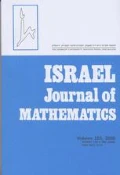Abstract
We study the question of whether or not it is possible to determine a finitely generated group G up to some notion of equivalence from the spectrum sp(G) of G. We show that the answer is “No” in a strong sense. As a first example we present the collection of amenable 4-generated groups Gω, ω ∈ {0, 1, 2}ℕ, constructed by the second author in 1984. We show that among them there is a continuum of pairwise non-quasi-isometric groups with \({\rm{sp}}(G_\omega)=[-\frac{1}{2},0]\cup[\frac{1}{2},1]\). Moreover, for each of these groups Gω there is a continuum of covering groups G with the same spectrum. As a second example we construct a continuum of 2-generated torsion-free step-3 solvable groups with the spectrum [-1, 1]. In addition, in relation to the above results, we prove a version of the Hulanicki Theorem about inclusion of spectra for covering graphs.
Similar content being viewed by others
References
A. Abdollahi, S. Janbaz and M. Ghahramani, A large family of cospectral Cayley graphs over dihedral groups, Discrete Mathematics 340 (2017), 1116–1121.
L. Babai, Spectra of Cayley graphs, Journal of Combinatorial Theory. Series B 27 (1979), 180–189.
L. Bartholdi and R. I. Grigorchuk, On the spectrum of Hecke type operators related to some fractal groups, Trudy Matematicheskogo Instituta Imeni V. A. Steklova 231 (2000), 5–45.
B. Bekka, P. de la Harpe and A. Valette, Kazhdan Property (T), New Mathematical Monographs, Vol. 11, Cambridge University Press, Cambridge, 2008.
M. G. Benli, R. Grigorchuk and P. de la Harpe, Amenable groups without finitely presented amenable covers, Bulletin of Mathematical Sciences 3 (2013), 73–131.
M. Bozejko, K. Dykema and F. Lehner, Isomorphisms of Cayley graphs of surface groups, Algebra and Discrete Mathematics 1 (2006), 18–37.
T. Ceccherini-Silberstein, R. Grigorchuk and P. de la Harpe, Amenability and paradoxical decompositions for pseudogroups and discrete metric spaces, Trudy Matematicheskogo Instituta Imeni V. A. Steklova 224 (1999), 68–11.
P. de la Harpe, A. G. Robertson and A. Valette, On the spectrum of the sum of generators for a finitely generated group, Israel Journal of Mathematics 81 (1993), 65–96.
P. de la Harpe, A. G. Robertson and A. Valette, On the spectrum of the sum of generators for a finitely generated group. II, Colloquium Mathematicum 65 (1993), 87–102.
J. Dixmier, Les C*-algèbres et leurs représentations, Les Grands Classiques Gauthier-Villars, Éditions Jacques Gabay, Paris, 1996.
A. Dudko and R. Grigorchuk, On spectra of Koopman, groupoid and quasi-regular representations, Journal of Modern Dynamics 11 (2017), 99–123.
K. Fujiwara, Can one hear the shape of a group?, in Geometry and Topology of Manifolds, Springer Proceedings in Mathematics & Statistics, Vol. 154, Springer, Tokyo, 2016, pp. 139–146.
C. Gordon, D. Webb and S. Wolpert, Isospectral plane domains and surfaces via Riemannian orbifolds, Inventiones Mathematicae 110 (1992), 1–22.
R. Grigorchuk, Degrees of growth of finitely generated groups and the theory of invariant means, Izvestiya Akademii Nauk SSSR. Seriya Matematicheskaya 48 (1984), 939–985.
R. Grigorchuk, A. Pérez and T. Smirnova-Nagnibeda, Spectrum of Schreier graphs of spinal groups, preprint.
P. Hall, Finiteness conditions for soluble groups, Proceedings of the London Mathematical Society 4 (1954), 419–436.
N. Higson and G. Kasparov, Operator K-theory for groups which act properly and isometrically on Hilbert space, Electronic Research Announcements of the American Mathematical Society 3 (1997), 131–142.
A. Hulanicki, Groups whose regular representation weakly contains all unitary representations, Studia Mathematica 24 (1964), 37–59.
A. Hulanicki, Means and Følner condition on locally compact groups, Studia Mathematica 27 (1966), 87–104.
M. Kac, Can one hear the shape of a drum?, American Mathematical Monthly 73 (1966), 1–23.
H. Kesten, Full Banach mean values on countable groups, Mathematica Scandinavica 7 (1959), 146–156.
H. Kesten, Symmetric random walks on groups, Transactions of the American Mathematical Society 92 (1959), 336–354.
M. G. Kuhn, Anisotropic random walks on free products of cyclic groups, irreducible representations and idempotents of C*reg(G), Nagoya Mathematical Journal 128 (1992), 95–120.
A. Lubotzky, B. Samuels and U. Vishne, Isospectral Cayley graphs of some finite simple groups, Duke Mathematical Journal 135 (2006), 381–393.
I. Lysionok, A system of defining relations for the Grigorchuk group, Matematicheskie Zametki 38 (1985), 503–511.
W. Magnus, A. Karrass and D. Solitar, Combinatorial Group Theory: Presentations of Groups in Terms of Generators and Relations, Interscience John Wiley & Sons, New York-London-Sydney, 1966.
Y. Muntyan, Automata groups, Ph.D. thesis, Texas A&M University, May 2009.
H. Neumann, Varieties of Groups, Springer, Berlin, 1967.
A. Ol’ˇsanski˘ı, On characteristic subgroups of free groups, Uspekhi Matematicheskikh Nauk 29 (1974), 197–180.
A. Valette, Can one hear the shape of a group?, Rendiconti del Seminario Matematico e Fisico di Milano 64 (1994), 31–44.
Acknowledgements
We are grateful to the anonymous referee for careful reading of our paper and numerous useful comments and suggestions.
Author information
Authors and Affiliations
Corresponding author
Additional information
Artem Dudko acknowledges the support by the National Science Centre, Poland, grant 2016/23/P/ST1/04088 under POLONEZ programme which has received funding from the EU Horizon 2020 research and innovation programme under the MSCA grant agreement No. 665778.
Rostilav Grigorchuk was partially supported by NSF grant DMS-1207699 and by Simons Foundation Collaboration Grant for Mathematicians, Award Number 527814
Rights and permissions
About this article
Cite this article
Dudko, A., Grigorchuk, R. On the question “Can one hear the shape of a group?” and a Hulanicki type theorem for graphs. Isr. J. Math. 237, 53–74 (2020). https://doi.org/10.1007/s11856-020-1994-z
Received:
Revised:
Published:
Issue Date:
DOI: https://doi.org/10.1007/s11856-020-1994-z


